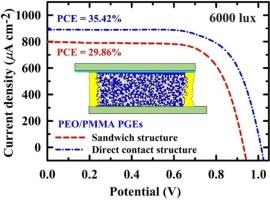Ambient light harvesting with high-performance printable electrolyte in direct contact structured dye-sensitized solar cells
IF 13.3
1区 工程技术
Q1 ENGINEERING, CHEMICAL
引用次数: 0
Abstract
For the first time, printable polymer gel electrolytes (PGEs) of the copper-redox system were developed for fabricating quasi-solid-state dye-sensitized solar cells (QS-DSSCs) using a printing process. Furthermore, these PGEs were employed to prepare QS-DSSCs with a direct-contact structure. Poly(ethylene oxide) (PEO) and poly(methyl methacrylate) (PMMA) were chosen as gelators for the PGEs. For sandwich-structured DSSCs, the optimal composition of the PGE contains 7 wt% gelators, with a PEO to PMMA weight ratio of 8:2. The electrochemical impedance spectroscopy (EIS) analysis demonstrated that the presence of PMMA in the PGE can improve the charge transfer at the counter electrode/PGEs interface. This PGE was then employed to fabricate QS-DSSCs with a direct contact structure. The results demonstrated that QS-DSSCs with a direct-contact structure achieved a notably higher PCE of 35.42% under room light illumination, which is significantly higher than that obtained by a sandwich-structured cell (29.86 %). The EIS analysis of the DSSCs indicated that the smaller charge transfer distance of the direct-contact cell led to a downward shift of the Fermi level, higher charge recombination resistance and longer electron lifetime. Among these, charge recombination inhibition was the main factor contributing to the higher PCEs of the direct-contact cell.

在直接接触式结构染料敏化太阳能电池中使用高性能可印刷电解质采集环境光
该研究首次开发了铜氧化还原体系的可印刷聚合物凝胶电解质(PGEs),用于利用印刷工艺制作准固态染料敏化太阳能电池(QS-DSSCs)。此外,还利用这些 PGE 制备了具有直接接触结构的 QS-DSSC。聚环氧乙烷(PEO)和聚甲基丙烯酸甲酯(PMMA)被选为 PGE 的凝胶剂。对于夹层结构的 DSSC,PGE 的最佳成分包含 7 wt% 的凝胶剂,PEO 与 PMMA 的重量比为 8:2。电化学阻抗光谱(EIS)分析表明,PGE 中 PMMA 的存在可改善对电极/PGEs 界面的电荷转移。然后,利用这种 PGE 制作了具有直接接触结构的 QS-DSSCs。结果表明,采用直接接触结构的 QS-DSSC 在室光照下的 PCE 显著提高,达到 35.42%,明显高于夹层结构电池的 PCE(29.86%)。对 DSSC 的 EIS 分析表明,直接接触电池的电荷转移距离更小,导致费米级下移,电荷重组阻力更大,电子寿命更长。其中,电荷重组抑制是导致直接接触电池的 PCE 值更高的主要因素。
本文章由计算机程序翻译,如有差异,请以英文原文为准。
求助全文
约1分钟内获得全文
求助全文
来源期刊

Chemical Engineering Journal
工程技术-工程:化工
CiteScore
21.70
自引率
9.30%
发文量
6781
审稿时长
2.4 months
期刊介绍:
The Chemical Engineering Journal is an international research journal that invites contributions of original and novel fundamental research. It aims to provide an international platform for presenting original fundamental research, interpretative reviews, and discussions on new developments in chemical engineering. The journal welcomes papers that describe novel theory and its practical application, as well as those that demonstrate the transfer of techniques from other disciplines. It also welcomes reports on carefully conducted experimental work that is soundly interpreted. The main focus of the journal is on original and rigorous research results that have broad significance. The Catalysis section within the Chemical Engineering Journal focuses specifically on Experimental and Theoretical studies in the fields of heterogeneous catalysis, molecular catalysis, and biocatalysis. These studies have industrial impact on various sectors such as chemicals, energy, materials, foods, healthcare, and environmental protection.
 求助内容:
求助内容: 应助结果提醒方式:
应助结果提醒方式:


